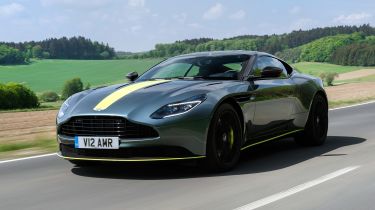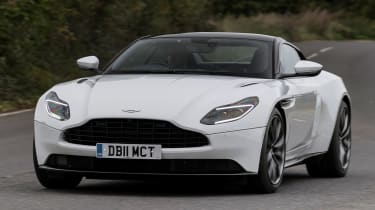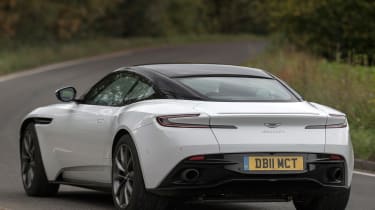Aston Martin DB11 (2017-2023) - Engines, performance and drive
The switch to turbocharging hasn’t robbed the Aston V12 of character, while the ride and handling balance is excellent

The DB11 is the first Aston to use the brand’s downsized V12 engine. However, any fears that a reduction in capacity – down from 6.0 to 5.2 litres – would lead to a drop in performance are unfounded. Thanks to the addition of a pair of turbochargers, the new unit pumps out a heady 600bhp (630bhp for the DB11 AMR) and a thumping 700Nm of torque.
The DBS Superleggera model screws even more power out of the V12, with 715bhp and 900Nm of torque and, as with its DB9 predecessor, all DB11s gets a traditional rear-wheel drive layout and a transaxle gearbox location. This means the eight-speed auto is mounted between the rear wheels, helping Aston’s engineers achieve a near-perfect 50/50 weight distribution.
As with its DB9 predecessor, the DB11 gets a traditional rear-wheel drive layout and a transaxle gearbox location. This means the eight-speed auto is mounted between the rear wheels, helping Aston’s engineers achieve a near-perfect 50/50 weight distribution.
Yet it’s the changes to the car’s structure and suspension that are really impressive. Aston has poached a number of chassis engineers from fellow British firm Lotus, and it’s clear their efforts have paid off, because the DB11 manages to handle with remarkable agility, yet it also soaks up bumps as effortlessly as an executive saloon.
Used - available now

2021 SEAT
Ibiza
25,933 milesManualPetrol1.0L
Cash £14,499
2023 Audi
A1 Sportback
21,137 milesManualPetrol1.0L
Cash £16,690
2022 Volkswagen
ID.4
40,867 milesAutomaticElectric
Cash £16,994
2022 Peugeot
3008
62,532 milesManualDiesel1.5L
Cash £15,559This newfound composure can partly be traced to the brand’s new scalable extruded and bonded aluminium architecture, which is far stiffer than the old VH platform used by the DB9, Vantage, Vanquish and Rapide. This allows the suspension geometry to work more consistently.
At the front is a traditional double wishbone set-up, while at the rear is an all-new multi-link axle. Adaptive dampers are standard, as is an electric power steering set-up.
Drivers can choose from three separate driving modes – GT, Sport and Sport+. Even in GT, the Aston feels remarkably poised and agile. The steering is quicker than in the DB9, but it never feels nervous or edgy, like in a Ferrari F12. The electrically assisted set-up is also naturally weighted and delivers just the right amount of feedback for a fast GT car.
As a result, the Aston responds quickly to inputs and can be placed with pinpoint accuracy. There’s plenty of bite from the front tyres and the Aston clings tightly to your chosen line, despite the fact that the torque vectoring system doesn’t start working until fairly high cornering forces are detected.
There’s also remarkably little roll through corners, while body movements are well checked even when the dampers are in their softest setting. Selecting Sport or Sport+ mode ties the car down a little more – it also adds weight to the steering, sharpens the throttle respones and changes the gearshift strategies – but for most people most of the time, GT will feel like the best judged setting.
As you’d expect from a car with so much power and rear-wheel drive, the DB11’s line through a corner can be influenced as much by the throttle as the steering.
Even with the stability control switched on, you can feel the car’s balance being altered by a sudden application of power. Sport+ mode relaxes the electronic safety net to allow a little slip on the exit of corners, meaning you can enjoy the car’s natural balance without fear of the situation getting out of hand.
The DBS Superleggera is even easier to unsettle with easily enough torque to overcome the huge Pirelli P Zero tyres. Unless you’re on a perfectly smooth bit of road without any camber, anything approaching full throttle will cause the Superleggera to squirm as the traction control fights to maintain order.
What may surprise you is that less is more in the DB11. The V8-engined model isn't as heavy as the V12 car, so it feels lighter on its toes, more nimble and alert to inputs from the steering. And, when you get to a corner, the lighter front end tucks in more quickly and with more precision.
Of course, the DB11 is a GT car first and foremost, so it needs to be as relaxing when you don’t want to drive like your hair is on fire. Leave the car in GT mode and the suspension does a remarkable job of soaking up bumps. Deeper potholes and sharp ridges are felt, but that’s largely to do with the massive 20-inch alloys.
It’s fairly refined, too, so you’ll be more than comfortable enough covering huge distances in the DB11. The soft-top DB11 Volante loses just a tenth of a second to the V8 coupe in the 0-62mph dash, while the absence of a fixed roof does little to harm overall driving dynamics.
Engines
There are only two engines available, but they're both crackers. The range-topping 5.2-litre V12 is smaller than the old 6.0-litre unit in the Aston DB9, but the addition of a pair of turbochargers means that there’s a stonking 600bhp available at 6,500rpm, rising to 630bhp at the same rpm for the DB11 AMR and 715bhp for the DBS Superleggera. More impressively, there’s a rippling 700Nm of torque for the lower-powered models and a hefty 900Nm for the DBS.
As you’d expect, performance is blistering. Aston claims the V12 DB11 will blast from 0-62mph in just 3.9 seconds, before thundering on to a supercar-baiting top speed of 200mph. The DB11 AMR model deals with 0-62mph in 3.7 seconds and pushes the top speed to 208mph. DBS models improve on this further with a 0-62mph time of 3.4 seconds and a top speed of 211mph.
These figures look good on paper, but the Aston feels even more impressive in the real world. Despite being the brand’s first turbocharged unit, the engine feels almost naturally aspirated in its delivery. There’s virtually no turbo lag and it pulls strongly from just above idle all the way round to the 7,000rpm redline. The powerplant’s linear delivery means that there’s no sudden rush of acceleration; it simply gathers speed deceptively quickly.
Turbochargers often muffle an engine’s natural exhaust note, but happily Aston has paid careful attention to the DB11’s soundtrack. Press the starter button and the V12 erupts noisily into life – although there is the option of a quieter start if you don’t want to annoy the neighbours when you need to make an early morning getaway.
At low revs the engine emits a purposeful growl, while working the unit hard results in Aston’s trademark howl. It’s not as loud as a Ferrari V12, but it’s noisy enough and packed with character. More importantly, it’s all-natural, as Aston’s engineers didn’t want to use sound generators that boost the noise by playing it through the stereo’s speakers.
The eight-speed automatic gearbox shifts smoothly when left to its own devices, yet delivers quick and crisp manual changes via the tactile aluminium paddles mounted on the steering wheel. The speed and ferocity of the shifts can be altered by engaging he Sport and Sport+ driving modes, but as with the steering and throttle, GT is the set-up you’re likely to use most of the time.
The only alternative engine to the V12 is a 4.0-litre turbocharged V8. And, while it's less powerful than the V12, with 503bhp and 685Nm of torque, you don't notice a huge amount of difference on the road. In fact, it's only a tenth of a second slower to 60mph than the original DB11 V12, and because the V8 car is lighter, it feels more nimble and responsive.
To cap it all, it also has a much more aggressive exhaust note than the V12 (though the DB11 AMR features a fruitier note than the V12 it replaced), which ramps up in ferocity when you cycle through the GT, Sport and Sport+ driving modes.








